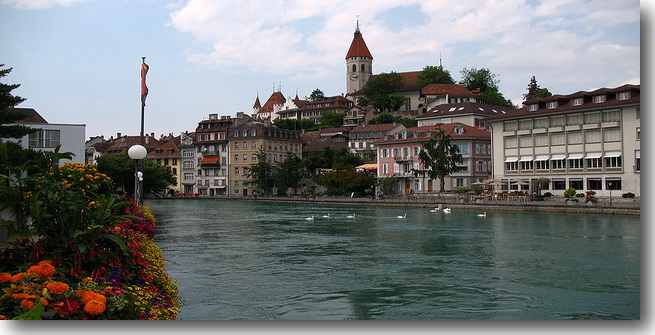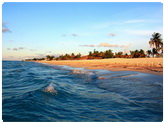| Quick Facts: | Aare River |
|---|---|
| Countries: | Switzerland |
| Towns: | Bern |
| Mouth: | Rhine |
| Length: | 183 mi (295 km) |
| Basin: | 6.865 mi² (17.780 Km²) |
The Aare River, also known as the Aar, is the longest river flowing entirely in Switzerland, and drains an area of 17, 780 km² or 6,865 mi². It travels about 183 miles from a glacial source in the Bernese Alps near Grimsel Lake, it passes by Meiringen, through the Aare Gorge, into Lake Thun, past Bern, and joins the Rhine River at the village of Koblenz, near the Swiss border with Germany.
The name Aare derives from the Indo-European syllable Aa, meaning “water.” There is even one small tributary of the Aare, the Aa which empties into the lower river. The Aare River rises in the Bernese Alps in the north-central part of Europe’s highest mountain range.
Pleistocene glaciation has interrupted the natural flow of the stream and dispersed lakes along its course. The glacially fed headwaters of the Aare pass through the scenic gorge of the Aareschlucht near Meiringen.
The river runs generally westward through Lake Brienz in the direction of the resort town of Interlaken, where it is canalized. From there it passes through Lake Thun, the head of navigation. Continuing northwest the river loops around the city of Berne, the Swiss federal capital, the medieval core of which with its splendid town hall and elaborate clock tower is surrounded by a wide meander of the river. Past Berne, the river turns northeast and flows past the cities of Solothurn and Aarau before joining the upper Rhine River opposite the German city of Waldshut.
The lower river has been altered by human activity, with dams, canals, channelization, and reservoirs being constructed. There are more than 40 hydroelectric plants on Aara, and two canals join the river with Lake Biel in the western part of Switzerland.
For many, the Aare is the entrance way to Oberland. On the way north from the federal capital to the city of Thun, on the lake with the same name, there are delightful river scenes of meadows, forests, reed grasses, sedges, and backwaters, much of which has been well preserved today. Upon reaching the interconnected lakes of Thun and Brienz, the traveler is presented with dazzling views of Alpine peaks, including the 13,642-foot Jungfrau. The natural highlights of this portion of Switzerland are the high Aare, its cataracts, the passes to the south, and the surrounding peaks.





